Beautiful, shelled reptiles roam the earth, hiding among twigs, tree roots, plants, and waves. These creatures, coming in 18 different shades and accent colors, are turtles. Depending on where in the world the animals live, their coloration varies from vivid green to startling white. Many turtles have colorful markings in red, pink, orange, or yellow, while others come in neutral shades. The reason for all these colors? Camouflage. Let’s take a look at these incredible creatures and the stunning turtle colors of the planet.
What Gives Turtles Their Color?
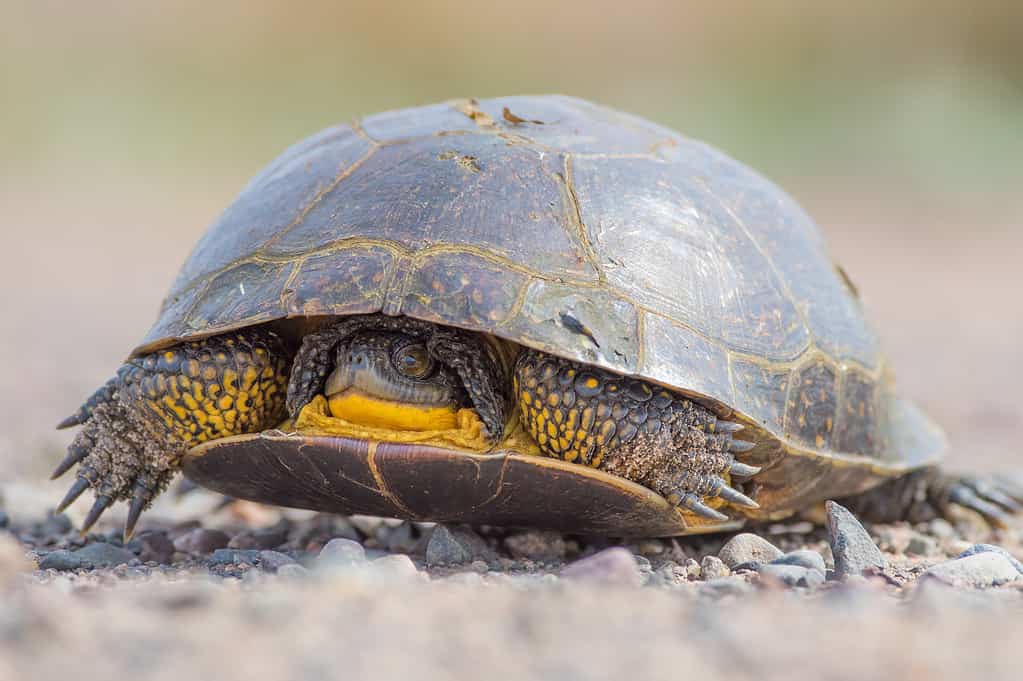
The Blanding’s turtle blends into its environment with its dark brown shell and vivid yellow markings. Just 2 of 18 turtle colors.
©BobGrif/iStock via Getty Images
Turtles, whether terrestrial, semi-aquatic, or fully aquatic, typically have coloration that helps them blend into their environment. This means that turtles living in the ocean have more aquatic colors, while land turtles have more earthy coloration. The colors allow these animals to hide from predators more easily.
In most cases, the tops of turtle shells, known as the carapace, are darker than their undersides, the plastron. That is, most turtles have dark or vivid backs and white to tan bellies. This coloration helps turtles blend in underwater, as well.
All Turtle Colors — Shells and Markings

The bold, yellow turtle color actually helps some of these species and subspecies blend into their environments. This is especially true of box turtles and semi-aquatic turtles.
©iStock.com/Charlotte Bleijenberg
Turtles of all types typically come in varying shades of green, gray, brown, or black as their dominant colors. However, they often bear markings in a wide range of more vivid colors.
- Dark brown
- Black
- Reddish-brown
- Dark gray
- Mottled gray
- Gray
- Dark green
- Bright green
- Olive green
- Tan
- Red
- Yellow
- Orange
- Pink
- Purple
- Off-white/cream
- Gold
- White
Sea Turtle Colors
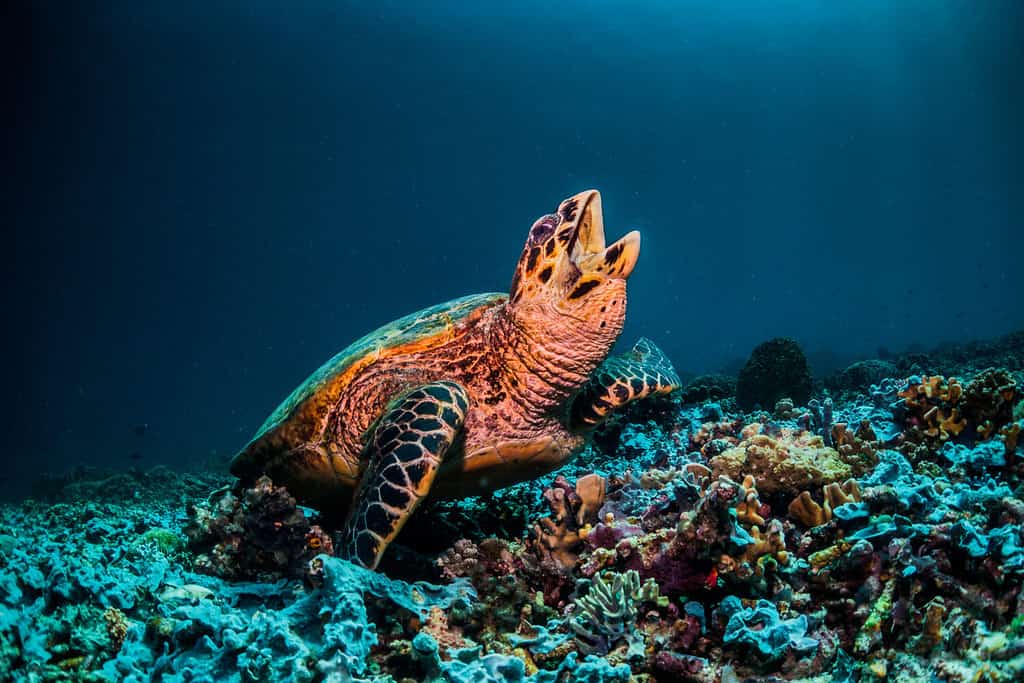
Sea turtles come in mostly aquatic themed colors so that they may blend in. This helps to keep them safe from predators roaming the oceans.
©Aaronejbull87/Shutterstock.com
Sea turtles, the flippered beauties of the world’s oceans, may come in a range of yellow to black colors. Specifically, they most commonly appear in olive green, yellow, green-brown, brown, reddish-brown, or black.
Markings for sea turtles may come in streaks, blotches, or patches, in brown, black, yellow-green, green-brown, or white. Green sea turtles actually get their name from their body fat coloration (due to their diet of green seagrasses) not their shells. The black subspecies of green sea turtle is still green, though, just a much darker shade.
Most sea turtles have counter-shades of dark dorsal and light ventral coloration. This countershading helps them hide in the ocean’s depths from predators.
Semi-Aquatic Turtle Colors
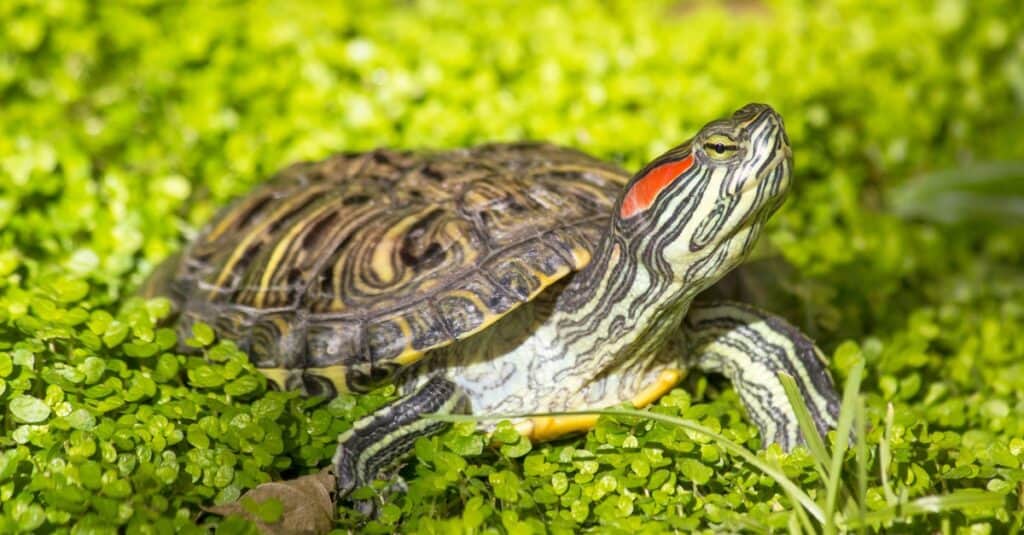
Red-eared sliders have bold red patches where “ears” should be. This is why they gained their name.
©xbrchx/Shutterstock.com
Most pet turtles fall into the semi-aquatic category. This means these beautiful reptiles both live on land, basking in the light, and hanging out in the water where they feed. Probably the most well-known semi-aquatic turtle species I the red-eared slider. Many folks bring these little guys home as their first pet turtle.
The majority of semi-aquatic turtles come in brighter colors, often with red, orange, pink, bright green, or yellow markings across their bright to dark green or brown to black bodies. The markings frequently dance across their faces, shells, and underbellies, spreading out to legs and feet.
Terrestrial Turtle Colors
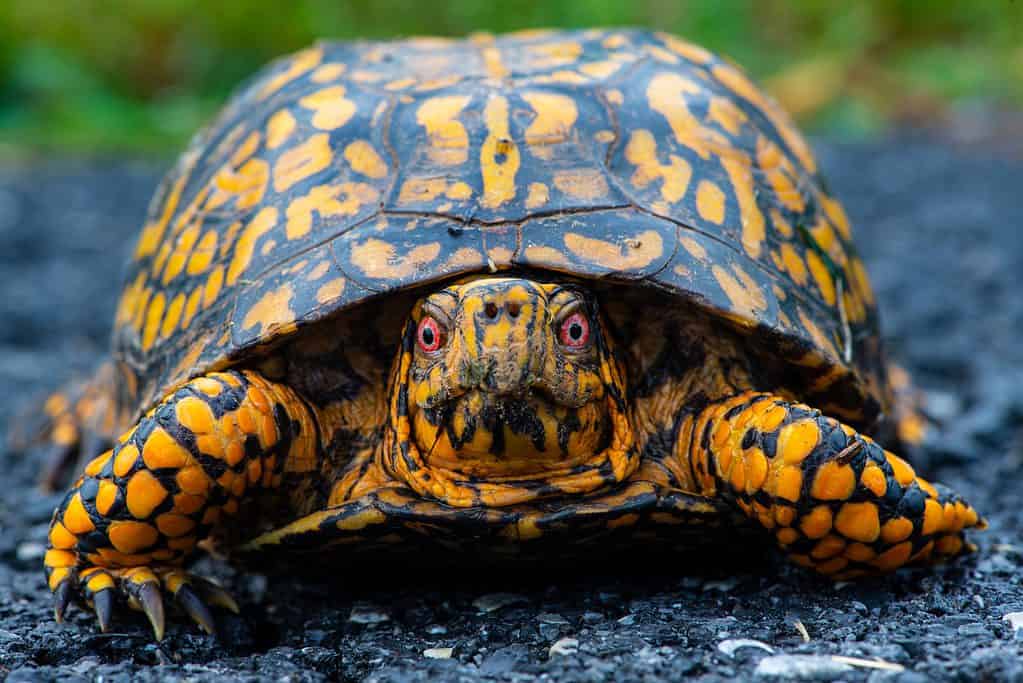
The box turtles of North America have dome-shaped shells which hinge at the bottom. They have red eyes and bold yellow markings in most cases.
©RenEgAdeRooStEr/Shutterstock.com
Land turtles may come in a variety of colors. Most of these are tortoises or box turtles and their subspecies. These land animals generally come in shades of olive green, tan, brown, dark brown, and reddish browns. Their markings may come in orange, yellow, olive-green, or darker brown shades than the rest of their shells.
A great example of these colorful terrestrial turtles is the Florida box turtle. This animal bears a dark brown to black shell with yellow to orange spots, stripes, streaks, or unusually shaped figures on their shells. Their heads are dark with yellow or orange stripes or markings. This kind of pattern is fairly common for a variety of land turtles.
Turtles and Their Colors
You may find turtles primarily in some shade of gray, brown, green, or dark yellow. However, many turtles have markings and other coloration as part of their overall coloring. It’s easiest to describe these by species and subspecies, though.
| Turtle Name | Coloration |
|---|---|
| Common snapping turtle | dark brown or black with yellow or orange spots |
| Loggerhead turtle | reddish-brown with yellow |
| Eastern painted turtle | dark brown to black with red and yellow |
| Blanding’s turtle | gray to black with yellow |
| African helmeted turtle | olive-green with yellow |
| White-lipped mud turtle | light gray to brown with darker markings |
| Yellow-blotched map turtle | olive green to dark brown with yellow |
| Mekong snail-eating turtle | olive green to brown with yellow |
| Red-eared slider | bright green with yellow and red |
| Green sea turtle | olive green to black |
| Eastern box turtle | dark brown or black with orange or yellow |
| Spotted turtle | mostly black with yellow |
| Northern giant musk turtle | olive-green with darker and lighter shades |
| Red-footed tortoise | tan to dark brown |
| Indian star tortoise | golden to near black with light and dark star shaped markings |
| Flowerback box turtle | olive-brown with orange, pink, purple, white, or cream concentric rings |
| Red-bellied short-neck turtle | browns with red |
| Furrowed wood turtle | dark gray to olive |
| Hilarie’s toadhead turtle | gray to olive |
| Pink bellied side neck turtle | mostly gray with pink markings |
| Pancake tortoise | golden |
| Ringed map turtle | olive to dark brown with light markings |
| Spotted flapshell turtle | gray to brown, or mottled gray-black flooring |
Other turtles bear basically these colors and color combinations, depending on their species.
What Is the Rarest Turtle Color?
Three colors of turtles may be considered the rarest. The first, and far more likely to be seen by humans, is the gold to white coloring of albino turtles. The lack of pigment melanin produces this coloration rarely. Generally, these occur in specific species only, including skinner’s box turtles and red-footed tortoises.
The second, equally rare color, is a white turtle. These are sea turtles dealing with leucism. These extremely rare cases occur as a genetic defect typically in sea turtles that spend a great deal of time in the depths of the ocean.
The third rarest coloration in turtles is yellow and black patterning in sea turtles. The bright yellow and deep black spots, lines, or stripes, are almost never seen.
Do Turtles’ Shells Change Color?
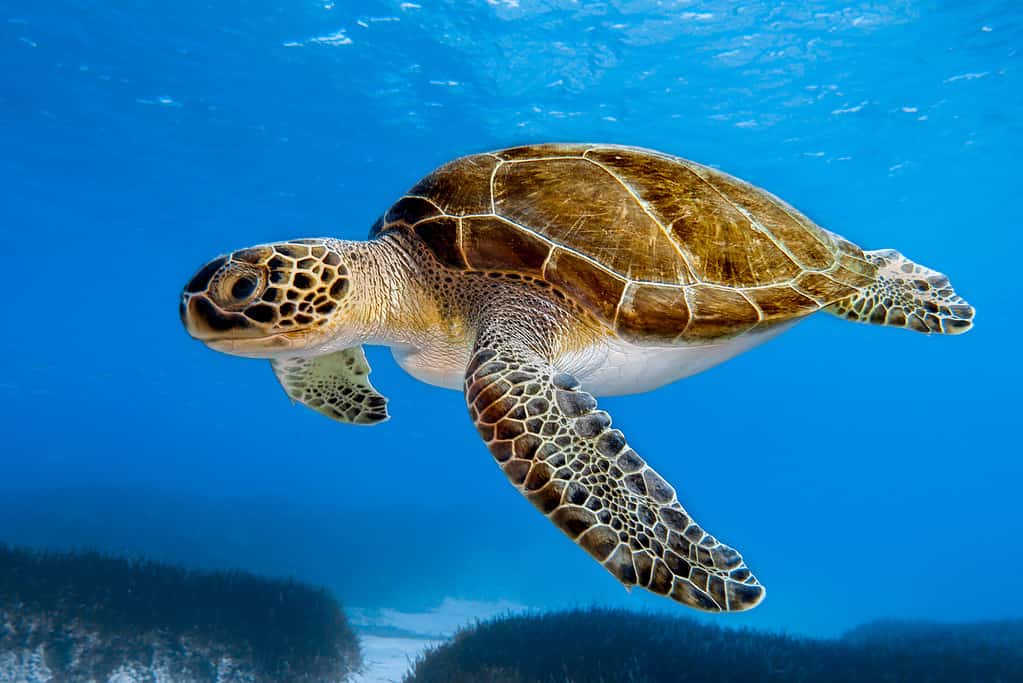
Turtle shell colors may change over the lifetime of a turtle. Or, in some species, during mating season!
©Sakis Lazarides/ via Getty Images
A number of turtle species have shells that change colors as they mature. In fact, nearly every species of turtle undergoes some kind of color change during its lifetime.
Terrapin turtles probably demonstrate the most significant color changes. These turtles, found in Borneo, Sumatra, and Malaysia, frequently change colors based on the season. During mating season, the gray-headed turtles with dull red stripes brighten the coloring of their stripes. Male terrapins also change their shell colors from pale gray to dark gray, almost black, during mating season. Both of these color changes assist in finding mates.
Additionally, intriguing examples of colorful terrestrial turtles include the gopher tortoise found in areas like Florida. These turtles come in yellow to orange or brown colors on their bodies with dark shells and yellow markings as juveniles. As adults, their coloration mellows out to a mild tan to brown.
Typically, baby turtles are also more brightly colored than the adults of their species. Often, after one or two years, the colors change, becoming either darker or more muted. Often, bright green turtles as babies develop dark green, brown, or black shells in their maturity. Some patterns may change, as well, over time, particularly in slider turtles.
Other species, however, remain the same color their entire lives. These species, like painted turtles, keep their patterns and colors from birth to passing.
Generally, these color changes (or lack thereof) are based on the natural environment in which the turtles live. Camouflage is needed for safety, so their shells adapt to help them blend in.
Can Turtles From the Same Species Have Different Colors?
Depending on the subspecies, yes, turtles from the same species may well come in different colors. Subspecies of turtles may vary in both shell and face colors. An example of this is slider turtles. Some have yellow bellies, some with red markings, and others with multiple markings that distinguish the subspecies from others.
Are There Any Albino Turtles?
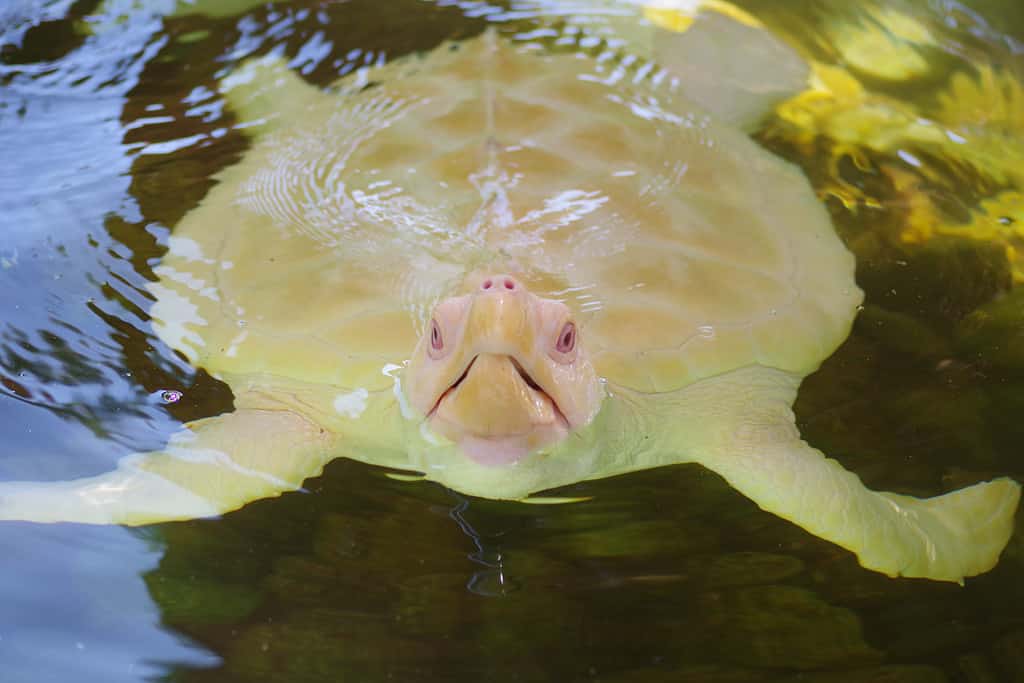
There are, indeed, albino turtles. Most commonly, though, they are at risk for both health (because of sunlight) and predation because of this coloration anomaly.
©Helge Masch/ via Getty Images
Albinism, inherited primarily from genetic mutations of parents, does exist in turtles. The genetic mutation interferes with the body’s ability to produce melanin (coloring). Generally speaking, this mutation results in turtles coming in white to yellow coloring. Unfortunately, while the condition is rarely problematic for health, it does make turtles vulnerable to predators. They cannot blend into their environment as other turtles do.
Note: White turtles also exist. These are deep sea turtles dealing with leucism, not albinism.
The photo featured at the top of this post is © Helge Masch/ via Getty Images
Thank you for reading! Have some feedback for us? Contact the AZ Animals editorial team.






